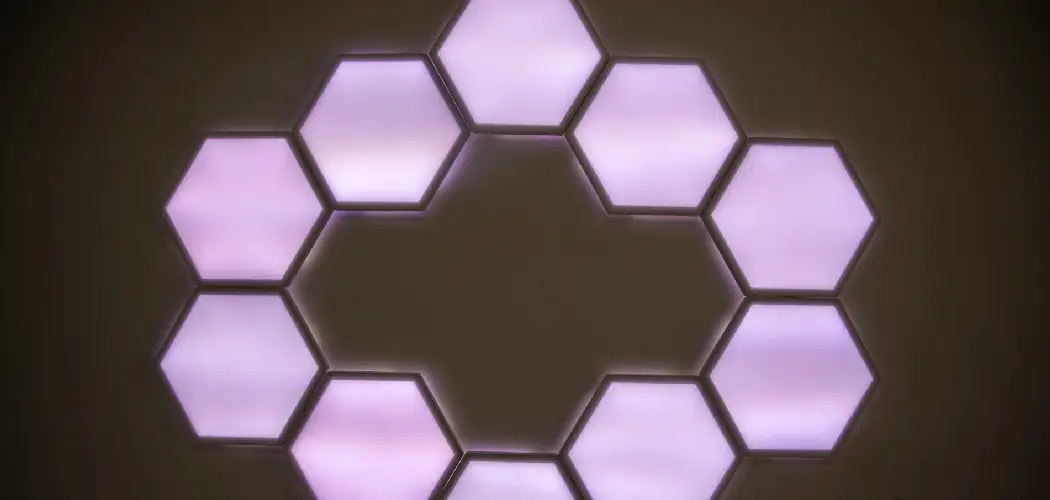Hexagon lights have captured the artistic vision of modern interior designers and DIY enthusiasts alike, rapidly rising to become a popular trend in lighting decor. Known for their unique geometric shape and modular capabilities, these lights offer endless creative possibilities, from accentuating architectural features to creating intimate ambient atmospheres.
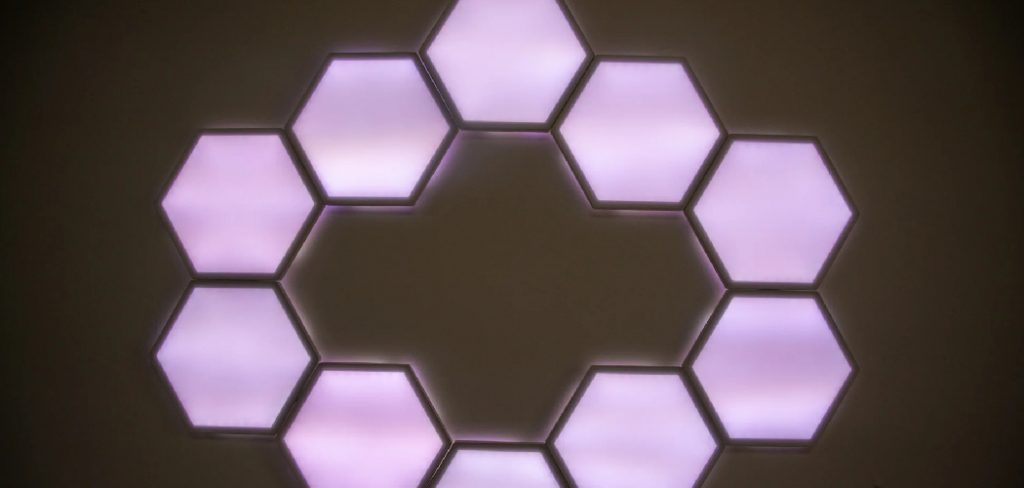
In this guide, we will explore the intricate details of how to install hexagon lights in your space. Whether you aim to add a splash of sophistication to your living room or a futuristic touch to your gaming setup, we provide a thorough walk-through for various settings.
Prepare to lighten up your world with style as we delve into the step-by-step process to illuminate your environment with these chic, versatile fixtures.
Types of Hexagon Lights
Hexagon-shaped lights are available in several classes, each catering to different design needs and installation preferences. Wall-mounted hexagon lights are affixed directly onto surface walls and often serve as aesthetic focal points or to highlight particular areas. These require a secure attachment, typically involving drilling and using anchors or screws.
Moving upwards, ceiling-mounted lights transform overhead spaces and can provide either a broad distribution of light or a focused ambiance, depending on their arrangement. They need specific mounting hardware that usually accompanies the product for a solid fix.
Free-standingFree-standing hexagon lights are more versatile in terms of placement and easily relocated to change a room’s mood as desired.
Lastly, adhesive-backed lights are the go-to for a quick and hassle-free installation. They are perfect for renters or those seeking a temporary decorative touch, adhering to most flat surfaces with pre-applied sticky backing.
Many hexagon lights come with variations such as being dimmable, changing colors, and integrating with smart home systems, allowing further customization and control over the lighting experience.
Planning and Design
Engaging in thoughtful planning and design is critical before diving into installing hexagon lights. This ensures your lighting vision comes to life both functionally and aesthetically. Consider the lights’ layout- whether they’ll form a continuous line, a unique pattern, or a centered cluster- as the number and arrangement of units will determine their overall impact and brightness.
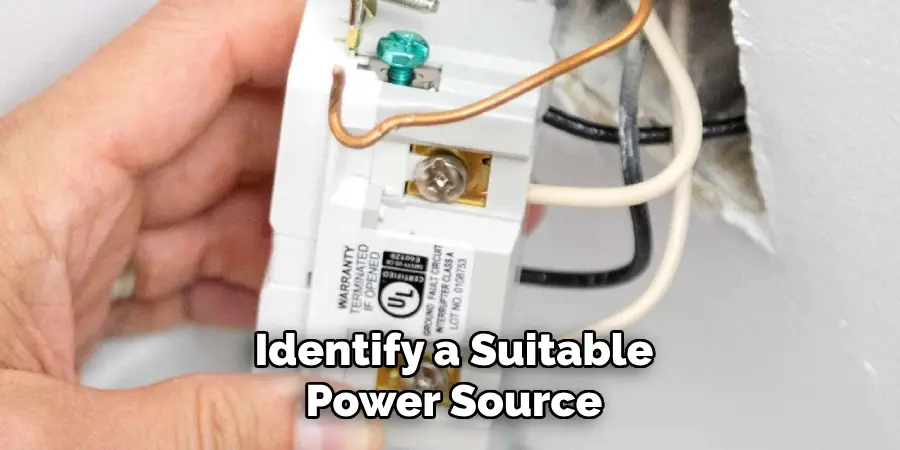
You’ll also need to identify a suitable power source, ranging from direct wiring for a permanent solution to plug-in transformers for ease of installation or even battery-powered units for the utmost flexibility.
Taking precise measurements of your installation area is essential to guarantee a harmonious fit within the space. Create a layout template using paper or a digital design application to visualize the end result and make any necessary adjustments before committing. Don’t forget to consider the spacing between each light for even distribution and optimal aesthetic value.
Additional considerations include incorporating dimmer switches to adjust the ambiance and the potential integration with smart home systems for ultimate lighting control. By meticulously planning, you craft a practical lighting setup and an interactive piece of art that resonates with your personal style and the functional needs of the space.
Choosing the Right Lights
Selecting the ideal hexagon lights for your space demands careful consideration of various key features. The size of the lights should complement the installation area’s scale without overwhelming it.
Voltage and wattage play vital roles; while the voltage must align with your home’s electrical system to avoid overloads, the wattage affects energy consumption and brightness levels. Consider color temperature as well: warmer hues typically create a relaxed ambiance, whereas cooler tones are known for their energizing effect.

Brightness, measured in lumens, dictates light intensity, so ensure that the lumen output suits your desired illuminance. Also, evaluate compatibility with control systems, particularly if you aim to integrate your lights with a smart home setup for features like remote dimming or scheduling.
It’s critical to glean this information from product descriptions and specifications or by contacting the manufacturer to ascertain compatibility with your existing fixtures, transformers, or control systems.
Avoid costly mismatches and inefficiencies by double-checking that the lights you select match the design intent and the technical requirements for a seamless and sustainable installation.
Gathering Tools and Materials
When preparing for the installation of hexagon lights, amassing the correct tools and materials is paramount to ensure a smooth and successful installation. Here’s a consolidated list tailored for each light type:
Common Tools:
- Level
- Tape measure
- Drill
- Screwdriver
- Wire strippers (for wiring)
- Pencil
Wall-mounted:
- Anchors
- Screws
- Hammer (for masonry)
Ceiling-mounted:
- Mounting hardware specific to the chosen system
Free-standing:
- Base stand or platform (if needed)
Adhesive-backed:
- Cleaning supplies
- Surface primer (optional)
Additional Materials:
Based on your power source, you might also need:
- Wires (for hardwiring)
- Connectors/terminal blocks
- Transformers, if the lights are low-voltage
- Control units for smart light integration or dimming capabilities
Always ensure the compatibility of these materials with your hexagon lights, and adhere strictly to the manufacturer’s instructions for safety and functionality. The correct preparation will translate to a seamless installation process, allowing your geometric lighting vision to come to fruition effortlessly.
How to Install Hexagon Lights: A Beginner’s Guide
Installing hexagon lights can dramatically alter a space, but the process requires meticulous attention to detail to ensure safety and accuracy. Here’s a comprehensive guide for each type of installation.
1. Wall-Mounted Installation:
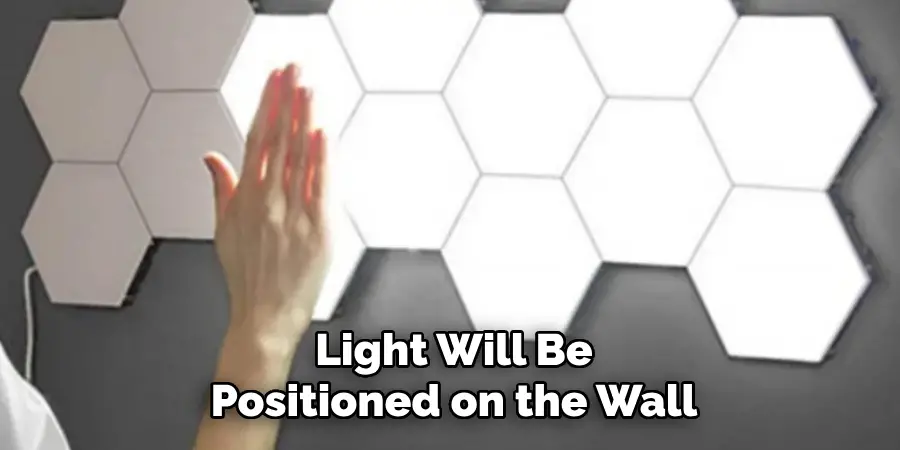
- Refer to your planning template and use a tape measure and pencil to mark where each hexagon light will be positioned on the wall.
- Place the level against the marks to double-check that each point aligns horizontally and vertically, adjusting as necessary to ensure an even layout.
- Drill a pilot hole at each marked point. If your wall is made of drywall, concrete, or brick, insert the appropriate wall anchors firmly.
- Line up the hexagon light mounts with the pilot holes or anchors, then secure them with screws. Use a level again to make certain each light is perfectly straight before moving on to the next one.
- Should your lights require an electrical connection, turn off the circuit breaker and strip the wires as needed. Connect the wires using connectors or terminal blocks, adhering to color coding for safety. Then, turn the electricity back on and test the lights before securing the light fixture in place.
2. Ceiling-Mounted Installation:
- Follow the manufacturer’s instructions closely; most will provide a template or a bracket for marking screw holes. Make sure the area where the lights will hang is clear of obstructions and can support the weight of the fixtures.
- Drill pilot holes where you’ve marked, install ceiling anchors if necessary, and attach the mounting hardware securely.
- Connect the electrical wires, ensuring power to the area is shut off at the circuit breaker. Wires should be matched according to color, twisted together, and covered with wire caps or enclosed in a junction box as per electrical codes.
- Attach the hexagon light fixtures to the mounted hardware after verifying that the electrical connections are safe.
3. Free-Standing Installation:
- If your hexagon lights require the assembly of a stand or platform, follow the included instructions to put these pieces together, ensuring they are stable and level.
- Place your free-standing hexagon lights on the stand or platform where desired. If they need to be connected to a power source, proceed carefully, following the product guidelines.
- Position the lights in their final location and plug them into an appropriate power outlet. Check the stability and adjust the position as needed.
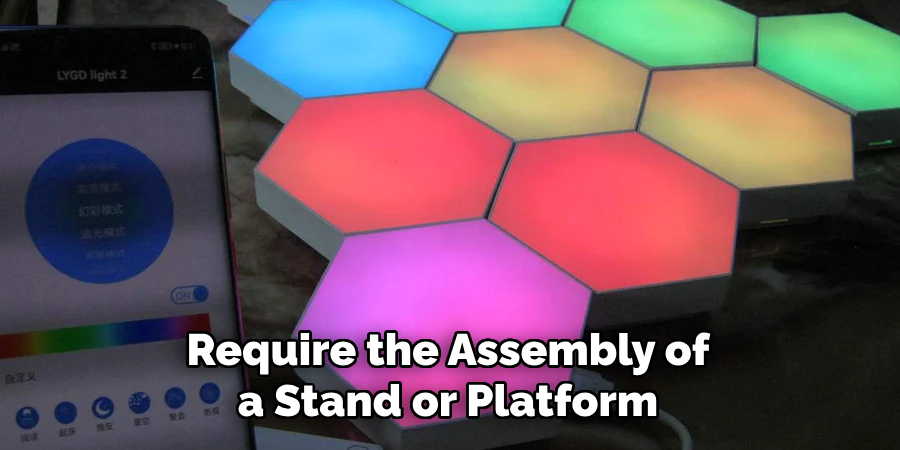
4. Adhesive-Backed Installation:
- Clean the surface where the lights will be installed with appropriate cleaning supplies. Let it dry thoroughly to ensure a good bond; use a surface primer if recommended.
- Peel off the backing from the adhesive pads on the hexagon lights, being careful not to touch the sticky surface more than necessary.
- Press the lights firmly against the surface for the time specified by the manufacturer, ensuring they are aligned and level.
5. Safety Considerations & Final Testing:
- Always adhere to safety guidelines when handling electrical components. If you’re unsure about performing any step that involves wiring, it’s best to consult with or hire a professional electrician.
- Follow the manufacturer’s instructions and safety warnings without deviation to prevent damage to the product and your home and avoid potential hazards.
- After installation, test all the lights to ensure they are functioning correctly. Look out for any flickering or dimming, which may indicate an issue with the power supply or connections.
- Ensure that all lights are securely attached and safely positioned away from moisture and heat sources.
That’s it! You’ve now learned how to install hexagon lights in various configurations, and you’re ready to transform your space with these stunning geometric fixtures. With proper installation and maintenance, your hexagon lights will provide a sustainable light source for years to come.
Enjoy the unique ambiance they create! So, gather your tools and materials, follow these instructions carefully, and let your creative lighting vision shine bright.
Wiring and Power Connection
Proper wiring and power connection are the lifeblood of any electrical installation, and this phase calls for careful adherence to safety principles to prevent electrical accidents or fires.

When engaging with direct-wired installations, always cut off power from the circuit breaker to avoid electrocution. If any step of the process seems uncertain or if complex wiring is required, the expertise of a qualified electrician is invaluable.
Basic wiring starts with understanding color codes — typically, black or red wires are “hot,” white wires are “neutral,” and green or bare copper wires are “ground.” To maintain a safe circuit, connect the light fixture’s corresponding colors to the home wiring.
Suppose your hexagon lights are to be incorporated into an existing circuit. In that case, it may be necessary to include a junction box to house wire connections, which should be installed in compliance with local electrical codes.
Moreover, fuses or circuit breakers are crucial as they safeguard against electrical overload. Once all connections are made, it’s imperative to double-check that everything is secure and properly insulated before restoring power.
Finally, conduct a thorough inspection to confirm that there are no loose wires or potential hazards, ensuring that your lighting operates efficiently and safely.
Testing and Finishing Touches
After installing hexagon lights, it is essential to conduct testing to confirm that each light is functional and illuminates as expected. Start by turning the power back on at the circuit breaker, then activate the light switch to check the performance of each unit.
Observe for evenness in lighting and any abnormal behaviors, such as flickering or dimming, which could suggest a fault in wiring or connectivity.
To wrap up, clean the installation area to remove any debris from drilling or wiring. Carefully use a soft cloth to wipe down the hexagon lights, removing fingerprints and dust that may have settled on their surfaces during the installation. This ensures a clean appearance and allows the lights to shine brightly without obstruction.
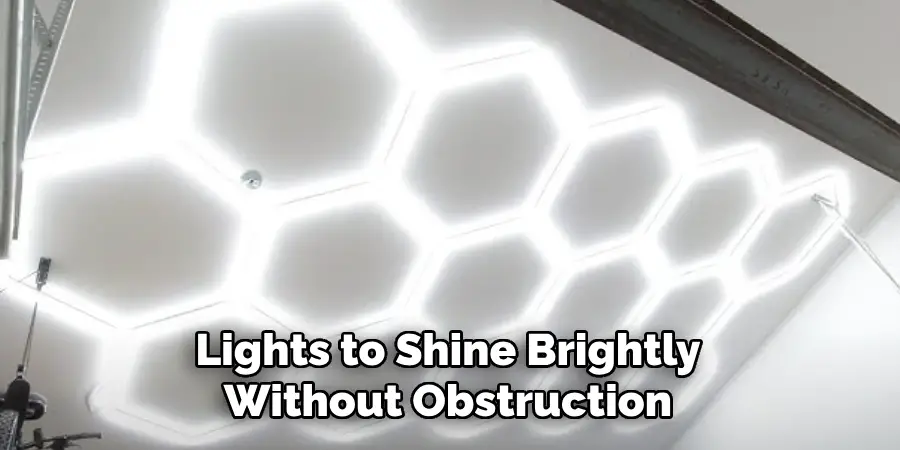
For troubleshooting, if any lights fail to operate, first ensure the power connection is secure, then check for properly connected and insulated wires, adhering to color-coded standards.
A bulb replacement or consulting the manufacturer’s guidelines may solve the problem if issues persist. Contact a professional electrician for further assistance in cases with technical difficulties beyond basic troubleshooting.
5 Benefits of Installing Hexagon Lights
As we continue to look for ways to elevate our living spaces, the role of lighting in home design has taken on innovative new forms. One such trend that has captivated the attention of interior design enthusiasts and smart homeowners alike is the installation of hexagon lights.
These futuristic fixtures go beyond mere illumination, offering a unique blend of aesthetics, functionality, and technology. If you’re considering a lighting upgrade, here are five standout benefits that hexagon lights can bring to your home.
1. Enhances Aesthetics
Hexagon lights are not mere sources of brightness; they are elegant design elements that can transform the atmosphere of a space. Here are two ways they do it:
Creates Ambiance
The warm glow of hexagonal lights creates a cozy atmosphere, perfect for setting the mood in living rooms, bedrooms, or even home offices. The geometric patterns they cast provide a touch of drama without overpowering the area, making them perfect for both relaxation and socializing.
Modernizes Space
Incorporating hexagon lights instantly adds a contemporary feel to any room, offering a unique visual appeal that newer homes strive to achieve. Their versatile design can blend with a range of interior styles, from industrial to minimalist, giving a timeless modern aesthetic.
2. Customizable Lighting
In the world of interior design, customization is key, and hexagon lights deliver exactly that when it comes to adjusting the intensity and color of your space’s lighting.
Color Options
With an array of color choices, these lights allow you to switch moods at the press of a button. Create a serene blue-lit ambiance for a spa day at home or a vibrant red hue for a social gathering. The only limit is your imagination.
Dimming Capabilities
Flexibility is further enhanced with dimming capabilities that offer fine control over the room’s lighting. Whether you need a bright space for work or a softly-lit area for movie night, hexagon lights have you covered with precise adjustments to suit any need.
3. Energy Efficiency
As LED technology continuously evolves, hexagon lights are at the forefront, offering homeowners increased energy efficiency and cost savings.
LED Technology
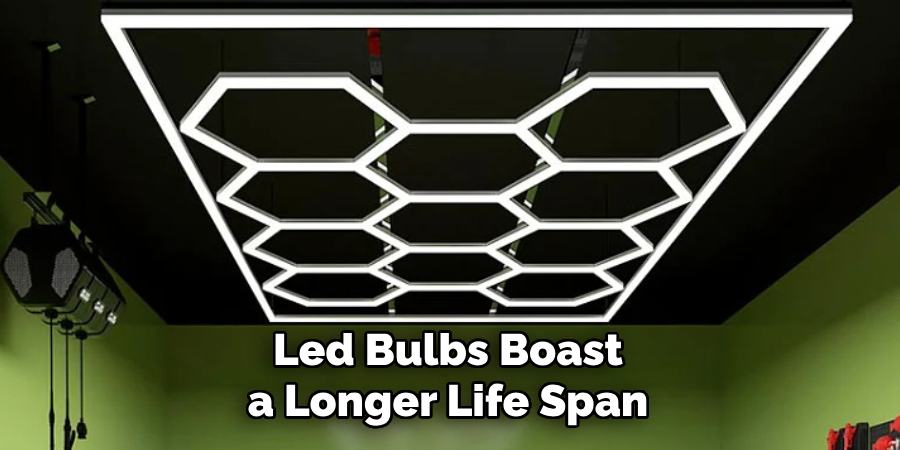
The LED bulbs in hexagon lights boast a significantly longer life span than traditional incandescent bulbs, saving you the hassle and cost of frequent replacements. Furthermore, LEDs emit less heat, making them environmentally friendly and reducing the load on your home’s cooling system.
Cost-Effective
While the initial investment in hexagon lights may be slightly higher than conventional options, the long-term savings on electricity bills and maintenance costs make them a cost-effective choice for eco-conscious and budget-minded homeowners.
4. Smart Home Integration
In the age of smart living, hexagon lights are not left behind, offering compatibility with various home automation systems to bring convenience and efficiency to a new level.
Compatibility with Smart Systems
Hexagon lights can be seamlessly integrated with popular smart home brands like Philips Hue or LIFX, allowing you to control them using your smartphone, voice commands, or even pre-set schedules.
Convenient Control Options
Forget about searching for light switches—the convenience of adjusting your hexagon lights from the comfort of your couch or the efficiency of doing so remotely while you’re away provides a level of home control that is both impressive and practical.
5. Increased Functionality
Beyond their striking appearance, hexagon lights prove to be practical additions to any room, serving purposes that traditional lighting may fall short of.
Task Lighting
The focused illumination of hexagon lights is ideal for task-oriented spaces such as kitchens and study areas where you need clear, concentrated light to work efficiently without straining your eyes.
Accent Lighting
Use hexagon lights to highlight architectural features, artworks, or specific room areas. They can be arranged in various patterns to create an art installation of their own or to draw attention to existing elements, adding depth and interest to your home decor.
Conclusion
Upon mastering how to install hexagon lights, the sense of accomplishment is profound as you enhance your living space with these contemporary fixtures. Their geometric beauty and customizable illumination offer both an aesthetic upgrade and functional luminosity. Whether wall-mounted, free-standing, or adhesive-backed, the process can be a gratifying DIY project.
However, it’s paramount to acknowledge when the task exceeds personal expertise, particularly in complex electrical scenarios. In such cases, refer to in-depth guides, reach out to the product’s customer service, or engage a certified electrician to ensure that the lights add elegance to your decor and are also installed with the utmost safety.
The glow of self-installed hexagon lights will serve as a daily reminder of your DIY endeavors, casting light on both your handiwork and your environment.

